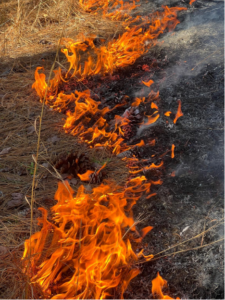A New Fire Future: Restoring Indigenous Sovereignty and Fighting Megafires Through a Return to Cultural Burning Practices

This blog post is the first in a five-part series written by Yale School of the Environment students enrolled in a graduate seminar that accompanied the spring 2025 Yale Forest Forum, “A History of People, Forests, and Forestry.” The webinar series and seminar were cohosted by the Yale Forest Forum and the Forest History Society.
Each student was asked to select a presentation and write an essay reflecting on what they learned. Maegan Bogetti chose "Karuk Forest and Fire Management: A Conversation with Bill Tripp and Tania Munz." You can watch the presentation video here: https://vimeo.com/1067859100.
***
In 2020, while in social isolation due to the COVID-19 pandemic, many watched through their screens as millions of acres of Australia burned in massive, devastating wildfires. Three years later in 2023, the Australian bushfire season saw nearly triple the acreage burned compared to the 2020 fires that captured the world’s attention. Across North America in 2023, communities experienced impacts from Canada’s largest wildfire of the century and witnessed a series of dramatic fires rip through the Hawaiian island of Maui. Just a week into 2025, an eruption of wildfires in California forced widespread evacuations as entire communities were engulfed in flames, many entirely decimated by the blaze.
Wildfires are getting more intense, more frequent, and more devastating as the global climate changes, and the past five years of high-profile disasters have given us a glimpse of what could be to come. However, there is another path available—a path that honors and respects fire as a forest management tool, a cultural touchstone, and a way of advancing Indigenous sovereignty—all while preventing calamitous megafires.
Indigenous groups such as the Karuk Tribe located in the northwestern corner of California have long used fire as a practice of ecosystem stewardship. Throughout the Karuk tribe’s deep history in the California area, starting and managing forest fires has been a vital piece of cultural heritage. This practice has promoted ecosystem health by reducing flammable material that can fuel spontaneous wildfires and encouraging new forest growth. Cultural fire practitioner Bill Tripp, the Director of Natural Resources and Environmental Policy, Karuk Tribe Department of Natural Resources, described that the smoke from the controlled fires can even influence qualities and temperatures of nearby water sources, aiding local species like salmon in their seasonal migratory cycles.
Bill Tripp began participating in cultural burns at just four years old. These experiences were accompanied by tribal ceremonies and stories told by elders that were embedded with principles of environmental care. These fires promoted whole-ecosystem health, including spiritual health for the tribes tending them.
As Indigenous groups across North America faced increasing intrusion of colonizers, not only were their lives and lands threatened and taken, but their cultural practices—including controlled burning—were also criminalized. With the rejection of this practice came an entering regime of forest management that centered fire suppression at all costs. When fires are suppressed, underbrush and other flammable, low-lying materials in forests and soils continue to accumulate, providing a bed of fuel whenever fires start. Fires then tend to burn faster, hotter, and larger, and spread quickly beyond control.
Today, as megafires grow more frequent, the fire suppression regime has come increasingly under question. On the frontlines of this crisis, California is turning to Indigenous fire management strategies that leverage not just deep ecological knowledge but also deep cultural and spiritual knowledge. Restoring Indigenous leadership of burning has (re)entered the forest management arena as an approach towards more adaptive and sustainable forestry policy, while also returning Indigenous sovereignty through the practice.
Thanks to critical advocacy work by Tripp and many others, California passed State Bill 310—“Prescribed Fire: Civil Liability: Cultural Burns”—in 2024. This new law has advanced the California Natural Resources Agency’s ability to establish and expand partnerships with federally recognized tribes, including the Karuk tribe, to manage Californian and tribal lands through beneficial burning.
Bill Tripp described this progress towards restoring Indigenous sovereignty through the practice of cultural burning as “coming full circle.” During a conversation with Forest History Society President Tania Munz as a part of Yale Forest School’s Forest Forum series, he stated, “We’re getting into a new era of shared stewardship. It’s going to take all of us, and it’s going to take coordination between states and feds and tribes and local communities and academic institutions, because this is a monumental task we’re faced with.”
California’s SB 310 marked a step towards acknowledging the deep harm caused by historic suppression of Indigenous peoples and their practices—harm that hurt not just members of Indigenous tribes, but all of us. We can only step towards a future where we recognize the knowledge of those who stewarded the land before us, respect the land itself, and live in safer, healthier communities through trust. And trust is difficult, as Bill knows: “People don’t tend to believe things until they see them.” Seeing the devastation that the ever-more-common megafires cause has led many to finally believe that something different needs to happen to prevent more damage to our communities and environment. Now, through trust and partnership, Indigenous cultural fire practitioners like Bill Tripp are restoring the practice of controlled burning so that perhaps we can come together once again around fire as a practice of shared stewardship.
Maegan Bogetti is a Masters of Environmental Management student (Class of 2026) at the Yale School of the Environment.

